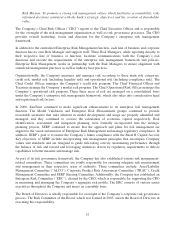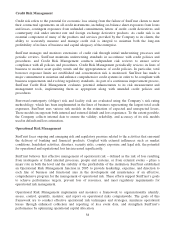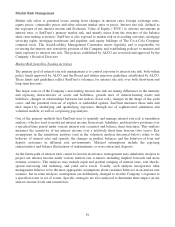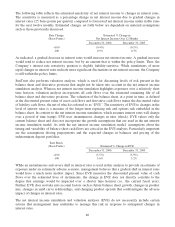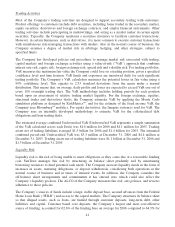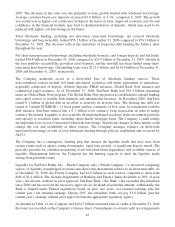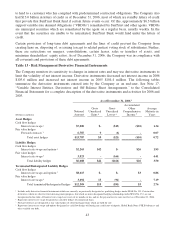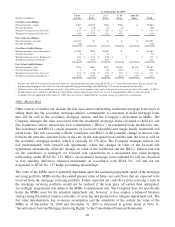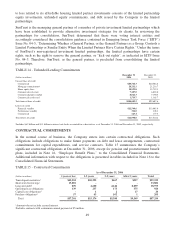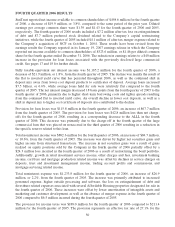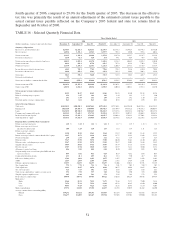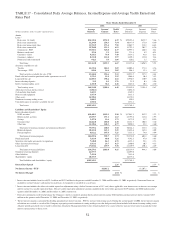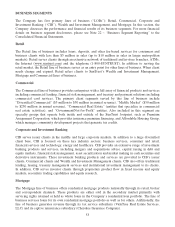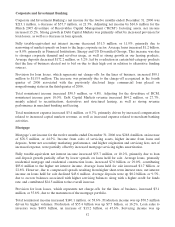SunTrust 2006 Annual Report Download - page 60
Download and view the complete annual report
Please find page 60 of the 2006 SunTrust annual report below. You can navigate through the pages in the report by either clicking on the pages listed below, or by using the keyword search tool below to find specific information within the annual report.The Company is also subject to risk from changes in equity prices that arise from owning The Coca-
Cola Company common stock. SunTrust owns 48.2 million shares of common stock of The Coca-Cola
Company, which had a carrying value of $2.3 billion at December 31, 2006. A 10% decrease in share
price of The Coca-Cola Company common stock at December 31, 2006 would result in a decrease, net
of deferred taxes, of approximately $144 million in accumulated other comprehensive income.
OFF-BALANCE SHEET ARRANGEMENTS
In the normal course of business, the Company engages in financial transactions that, in accordance with
US GAAP, are either not recorded on the Company’s balance sheet or may be recorded on the
Company’s balance sheet at an amount that differs from the full contract or notional amount of the
transaction. These transactions are structured to meet the financial needs of clients, manage the
Company’s credit, market or liquidity risks, diversify funding sources, or optimize capital.
As a financial services provider, the Company routinely enters into commitments to extend credit,
including, but not limited to, loan commitments, financial and performance standby letters of credit and
financial guarantees. While these contractual obligations could potentially result in material current or
future effects on financial condition, results of operations, liquidity, capital expenditures, capital resources,
or significant components of revenues or expenses, based on historical experience, a significant portion of
commitments to extend credit expire without being drawn upon. Such commitments are subject to the
same credit policies and approval processes accorded to loans made by the Company. See Table 14,
Unfunded Lending Commitments, for details on unfunded lending commitments.
The Company has undertaken certain guarantee obligations in the ordinary course of business. In
following the provisions of FASB Interpretation (“FIN”) No. 45, “Guarantors Accounting and
Disclosure Requirements for Guarantees,” (“FIN 45”) the Company must consider guarantees that have
any of the following four characteristics (i) contracts that contingently require the guarantor to make
payments to a guaranteed party based on changes in an underlying factor that is related to an asset, a
liability, or an equity security of the guaranteed party; (ii) contracts that contingently require the
guarantor to make payments to a guaranteed party based on another entity’s failure to perform under an
obligating agreement; (iii) indemnification agreements that contingently require the indemnifying party
to make payments to an indemnified party based on changes in an underlying factor that is related to an
asset, a liability, or an equity security of the indemnified party; and (iv) indirect guarantees of the
indebtedness of others. The issuance of these guarantees imposes an obligation to stand ready to
perform, and should certain triggering events occur, it also imposes an obligation for the Company to
make future payments. Note 18, “Guarantees,” to the Consolidated Financial Statements includes details
regarding the Company’s guarantee obligations under FIN 45.
In the normal course of business, the Company utilizes various derivative and credit-related financial
instruments to meet the needs of clients and to manage the Company’s exposure to interest rate and
other market risks. These financial instruments involve, to varying degrees, elements of credit and
market risk in excess of the amount recorded on the balance sheet in accordance with US GAAP.
SunTrust manages the credit risk of its derivatives by (i) limiting the total amount of arrangements
outstanding by an individual counterparty; (ii) monitoring the size and maturity structure of the
portfolio; (iii) obtaining collateral based on management’s credit assessment of the counterparty;
(iv) applying uniform credit standards maintained for all activities with credit risk; and (v) entering into
transactions with high quality counterparties that are periodically reviewed by the Company’s Credit
Management Committee. The Company manages the market risk of its derivatives by establishing and
monitoring limits on the types and degree of risk that may be undertaken. The Company continually
measures market risk by using a value-at-risk methodology. Note 17, “Variable Interest Entities,
Derivatives, and Off-Balance Sheet Arrangements,” to the Consolidated Financial Statements includes
47


